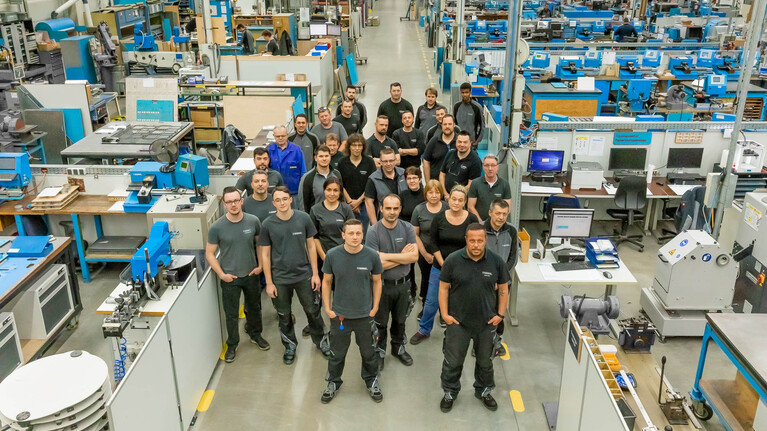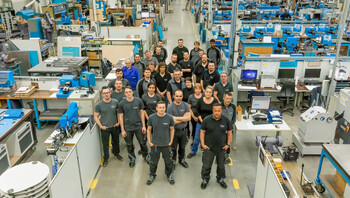100 years
Marbach Group
9. June 2023
100 years of Marbach (Part 8) On the way to becoming the world market leader: successes and employee development.
We can look back on a unique 100-year success story that continues today. Starting as a small craft business, today with more than 1,600 employees, we have become a globally operating manufacturer of cutting-dies and thermoforming tools for the packaging industry.
The 1950s and 1960s: the economic miracle.
After the 3-man operation in the 1920s, and even temporarily becoming a 1-man show, (More on this in Part 1: "100 years of Marbach. 1923 - 1927: The founding years." and Part 2: "100 years of Marbach. 1939 - 1945: The war years." of this series), Marbach experienced the postwar economic miracle. As a result, in 1957 the company in Fügerstrasse could be expanded to include its own toolmaking department. This was formed as an independent limited liability company in 1985. Today, Marbach Werkzeugbau manufactures thermoforming tools for the plastics industry and is an important pillar in the company group. In 1963, the old building in Fügerstrasse became too small for Marbach's approximately 40 employees. Karl Marbach decided therefore, to move the location of the company to August-Häusser-Strasse, where a new building had been constructed. The old location in Fügerstrasse was then used as a training center. (More on this in Part 7 of this series: "100 years of Marbach. More space and modern working: The new buildings.")
In the 1960s, rotary die-cutting of corrugated board became more and more popular. Marbach intensively engaged with this topic and started the production of rotary cutting-dies for corrugated board in 1968. This made Marbach one of the first companies to produce such rotary dies. From then on, and up to the present the department of rotary cutting-dies has grown continuously. Until today, they remain an important product in Marbach's extensive portfolio.
The 1970s and 1980s: the packaging industry booms.
The 1970s witnessed the beginning of the first self-service stores. The Heilbronn-based company Knorr had already been increasing its demand for packaging since the 1960s, but this triggered a boom in the entire packaging industry. Marbach customers Höhing, Landerer and Schilling, grew enormously during this time and so Marbach grew with its customers. Supported by this growth, Marbach started to develop its own laser systems.
When Marbach celebrated its 50th anniversary in 1973 with a ceremony in the Heilbronn House of Crafts, the company had already grown to about 145 employees. This growth would continue in the years to come. In 1977, yet more new buildings were erected. Opposite the building in August-Häußer-Straße 6, a new building with almost 3,000 m² was built. The Marbach Werkzeugbau department moved in here. This meant that, in the future the employees of the two fast-growing divisions Die-Cutting Technology and Toolmaking, now totaling 200, were housed in two separate buildings.
Marbach's productivity increased enormously due to new innovations introduced in various company divisions, one example was the first laser system in diemaking in Europe in 1972 (More about this in part 4 of this series: "100 years of Marbach. A major milestone: the use of lasers in die-cutting technology.") another the CAD programs in 1985 (More in part 5 of this series: "100 years of Marbach. Technologies, innovations and patents: Marbach sets market standards."). This continued to have a positive impact on the company's growth. The mid-1980s also saw the start of international expansion at Marbach, which has transformed the company into a global group of companies.
The 1990s: Expansion continues.
As early as 1990, construction was again underway at the headquarter in Heilbronn, as space had once again become too limited for the now 360 employees. The 1990s were characterized by the takeover and foundation of a number of companies in Germany and Europe. So, Marbach continued to grow steadily and in 1992 was already employing 465 people and five years later more than 500 employees.
Another success for the Marbach Group was the first DIN ISO 9001 certification. The year 1996 saw one of the most groundbreaking Marbach innovations, which is still a standard in diemaking today: the cutting rule mpower with its unique rounded cutting tip for significantly reduced knife-patching times. (Read more in part 5 of this series: "100 years of Marbach. Technologies, innovations and patents: Marbach sets market standards.")
Finally, in November 1998, Karl Marbach Junior was awarded the Economy Medal for outstanding services to the economy of Baden-Württemberg. The Economy Medal is an award for individuals or companies that serve the economy of Baden-Württemberg through special professional or entrepreneurial achievements.
The 2000s: The generation change.
The next awards for Karl Marbach Junior followed quickly. In 2001, the IADD (International Association of Diecutting and Diemaking) honored him as the first non-American to be awarded as "Diemaker of the year". This award was in recognition of his internationally acknowledged achievements in the development of new diemaking technologies. One year later, he was awarded the Golden Coin of the City of Heilbronn in recognition of his outstanding services to the city and its citizens. When Karl Marbach retired from the management in 2003 and handed the helm to the sole managing partner Peter Marbach, he could look back on half a century of activity in the service of the Marbach Group. In an interview he told journalists: "From this year on, I only work four days a week." This spirit distinguished him and was one of the reasons how Karl Marbach managed to create an internationally successful group of companies from his father's small craft business. When he celebrated his 80th birthday in 2007, Marbach employed about 1,000 people worldwide, one year later already 1,100.
The 2010s to the present: ready for the future.
Marbach continued to grow in the 2010s. The number of employees increased from 1,300 in 2016 to the current 1,600. Growth did not only come from Marbach's German operations but also from the foreign locations. In addition, Marbach had further globalized by opening new subsidiaries in countries such as America, Malaysia, China and Poland.
drupa 2016 was also a great success, where Marbach not only broke all previous attendance numbers at its stand, but also surprised visitors with its new visual appearance. (More about this in the third part of this series: "100 years of Marbach. Successful exhibitor: The trade fairs.")
Adding various services to the product portfolio has also been successful: trainings for customers are now offered at the Marbach Academy. The CONNECT|M system solution for thermoforming tools, but also for cutting-dies, has gained more and more momentum. Customer communication has been increasingly and successfully complemented by digital possibilities such as web sessions and a special online platform for customers. Always in focus: increasing customer performance.
On its journey from a craft business to a world market leader, Marbach has been able to celebrate many small and large successes. Each has contributed to the company's present day success. In the 100 years of company history, however, there have not only been successes, but also many challenges that had to be mastered. You will find out what these were in part 9 of this series: "100 years of Marbach. Challenges give us strength: new opportunities."

